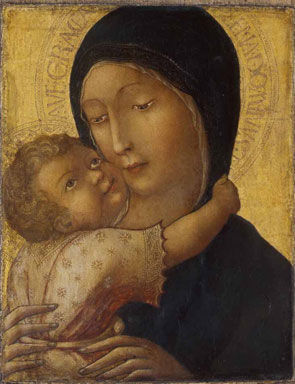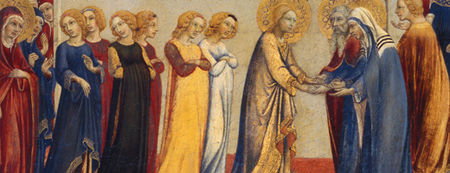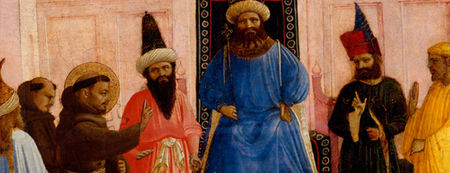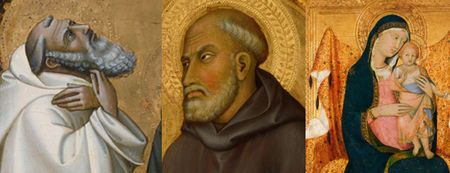"De Sienne à Florence... Les Primitifs Italiens. Collection d'Altenbourg" @ Musée Jacquemart-André
Liberale di Verona, Vierge à L’Enfant ,vers 1470. Détrempe sur panneau de bois 47 x 38 cm. ⓒ Bernd Sinterhauf, Lindenau Museum, Altenburg, 2008
« Hiératique et brillante de mille couleurs comme l’étaient autrefois nos cathédrales, la collection Lindenau offre l’image fascinante et rare de la peinture post-médiévale. »
Après le grand succès, en 2000, de l’exposition consacrée aux collections de Primitifs Italiens constituées par Nélie Jacquemart, le Musée Jacquemart-André ouvre ses portes à une autre collection,
La Collection du Musée d’Altenbourg
Cette collection de chefs-d’œuvre des Primitifs Italiens fut constituée au début du XIXe siècle par le baron allemand Bernard von Lindenau (1779-1854). Homme politique éminent, amateur d’art et philanthrope, Bernard von Lindenau ouvra en 1848, dans sa ville natale d’Altenbourg, au sud de Dresde, une vaste demeure de style classique afin d’y exposer ses collections d’œuvres d’art et de favoriser l’accès du plus grand nombre à la culture « pour l’éducation de la jeunesse et le plaisir des anciens ».
Avec la réunification allemande et la fin du régime communiste, les chercheurs occidentaux ont pu accéder de nouveau à cet ensemble unique tombé dans l’oubli. La valeur exceptionnelle de cette collection a été, alors, confortée par l’organisation de deux grandes expositions en Italie.
UNE EXPOSITION INEDITE DES PLUS GRANDS MAITRES
Une cinquantaine de ces œuvres, toutes réalisées par les plus grands maîtres de la pré-Renaissance et de la première Renaissance italienne sont réunies à l’occasion de cette exposition qui sera une révélation pour le public français.
Un florilège saisissant d’artistes prestigieux, de Guido da Siena à Liberale di Verona permet la confrontation de deux écoles majeures : celle de Sienne qui compte dans ses rangs Lippo Memmi, Pietro Lorenzetti ou Sano di Pietro et celle de Florence représentée, entre autres, par Fra Angelico, Lorenzo Monaco, Masaccio ou Filippo Lippi.
L’OCCASION D'UNE REDECOUVERTE ESTHETIQUE
Par son parcours, l’exposition met en lumière la succession des grands courants esthétiques qui transforment en profondeur l’art italien entre la seconde moitié du XIIIe siècle et la fin du XVe siècle. Le style grec et l’influence byzantine d’un côté et l’apparition du style moderne à la suite de Giotto et l’épanouissement du style gothique international de l’autre, laisse progressivement place au style renaissant.
LA RECONSTITUTION EXCEPTIONNELLE DE POLYPTYQUES DEMANTELES
Parmi les œuvres venues d’Altenbourg, certaines proviennent de polyptyques aujourd’hui dispersés. L’exposition sera l’occasion de reconstituer, en grande partie, certains d’entre eux, grâce aux prêts de grands musées français, allemands, anglais et italiens. Parmi ces ensembles, on remarquera, en particulier, une série d’œuvres de Fra Angelico sur la vie de Saint François.
UNE SELECTION EBLOUISSANTE
Les œuvres sélectionnées, mises en valeur par une scénographie originale signée Hubert Le Gall, soulignent la richesse et la grande diversité de plus de trois siècles de création picturale. On admirera le raffinement remarquable de la Vierge à l’enfant sur un trône de Lippo Memmi, le chatoiement des coloris de L’ascension de la Vierge par Sano di Pietro ou la douceur de la Vierge à l’enfant de Liberale di Verona.
La palette de couleurs puissamment symbolique des maîtres de Sienne ou de Florence émerveille le spectateur, en jouant sur les effets de camaïeux ou de contrastes entre les verts amande, les roses tendres ou « terre de sienne », les mordorés, les bleus profonds ou les rouges vifs.
Considered to be one of the largest collections of Italian Primitives outside Italy, the exceptional works collected during the 19th century by Bernard von Lindenau are being shown for the first time in Paris, through June 21. 2009, at the Jacquemart-André Museum.
Following the great success, in 2000, of the exhibition devoted to the collections of Italian Primitives gathered by Nélie Jacquemart, the Jacquemart-André Museum opened its doors to another collection, which is both different from and complementary to the first, dedicated to the masterpieces of the Italian masters of the 13th, 14th and 15th centuries.
The Altenburg Museum Collection
This collection of masterpieces by the Italian Primitives was acquired early in the 19th century by the German baron Bernard von Lindenau (1779-1854). An eminent politician, art enthusiast and philanthropist, Bernard von Lindenau opened a vast, classical-style house in his native town of Altenburg, south of Dresden, in 1848 in order to exhibit his collections of works of art and to encourage wider access to culture “for the education of the young and the pleasure of the old”.
With German reunification and the end of the Communist regime, western researchers were once again able to access this unique, forgotten collection. The exceptional value of this collection was then reinforced by the organisation of two big exhibitions in Italy.
A hitherto unseen exhibition of the greatest masters
Some fifty of these works, all painted by the greatest masters of the pre Renaissance and early Italian Renaissance have been brought together for this exhibition which has been a revelation for the visiting public.
An enthralling anthology of prestigious artists, from Guido da Siena to Liberale di Verona enable us to see two major schools side by side: the Sienese School, which counts Lippo Memmi, Pietro Lorenzetti and Sano di Pietro amongst its ranks, and the Florentine School, represented, amongst others, by Fra Angelico, Lorenzo Monaco and Filippo Lippi.
The occasion for an aesthetic rediscovery
Through the collection, the exhibition highlights the succession of major aesthetic trends which deeply transformed Italian art between the second half of the 13th century and the end of the 15th century. The Greek style and Byzantine influence on the one hand and the appearance of the modern style after Giotto and the spread of the international Gothic style on the other, gradually gave way to the Renaissance style.
The exceptional reconstitution of dismantled polyptychs
The works that have come from Altenburg include some that were originally from polyptychs, which have long been dismantled and dispersed. The exhibition provides the occasion to put most of them back together again, thanks to loans from French, German, English and Italian galleries. In particular, these collections include a series of works by Fra Angelico about the life of Saint Francis.
A dazzling selection
The works chosen, shown to their best advantage by an original scenography by Hubert Le Gall, highlight the wealth and great diversity of more than three centuries of pictorial creation. One is able to admire the remarkable refinement of Lippo Memmi’s Virgin and Child Enthroned, the sparkling colours of the Ascension of the Virgin by Sano di Pietro and the sweetness of the Virgin and Child by Liberale di Verona.
The radiance of the golds, the subtlety of the colours, the elegance of the lines, the expressive power of the scenes and the spiritual power of their message combine to give these works a poetry full of grace and depth. The Jacquemart-André Museum invites you to be charmed and bedazzled by these great masters of Italian painting of the 13th to 15th centuries.
Lippo Memmi, Vierge à l’Enfant, Vers 1320-1322, Détrempe sur panneau de bois, 51 x 34,3 cm © Bernd Sinterhauf, Lindenau Museum, Altenburg, 2008
Sano di Pietro, Marie retournant au Temple, 1448-1452, Détrempe sur panneau de bois, 31,7 x 47,4 cm © Bernd Sinterhauf, Lindenau Museum, Altenburg, 2008
Fra Angelico, La preuve par le feu de Saint François, 1429, Détrempe sur panneau de bois, 27,7 x 31,4 cm © Bernd Sinterhauf, Lindenau Museum, Altenburg, 2008

/https%3A%2F%2Fprofilepics.canalblog.com%2Fprofilepics%2F1%2F0%2F100183.jpg)
/https%3A%2F%2Fstorage.canalblog.com%2F03%2F02%2F119589%2F96711876_o.jpg)
/https%3A%2F%2Fstorage.canalblog.com%2F11%2F31%2F119589%2F94773502_o.jpg)
/https%3A%2F%2Fstorage.canalblog.com%2F20%2F83%2F119589%2F94772815_o.jpg)
/https%3A%2F%2Fstorage.canalblog.com%2F26%2F72%2F119589%2F75604929_o.jpg)
/https%3A%2F%2Fstorage.canalblog.com%2F59%2F60%2F119589%2F26458628_o.jpg)










/http%3A%2F%2Fstorage.canalblog.com%2F56%2F77%2F119589%2F117688917_o.jpg)
/http%3A%2F%2Fstorage.canalblog.com%2F92%2F84%2F119589%2F92142881_o.jpg)
/http%3A%2F%2Fstorage.canalblog.com%2F55%2F82%2F577050%2F38124415_p.jpg)
/image%2F1371349%2F20240418%2Fob_ac5c4c_telechargement.jpg)